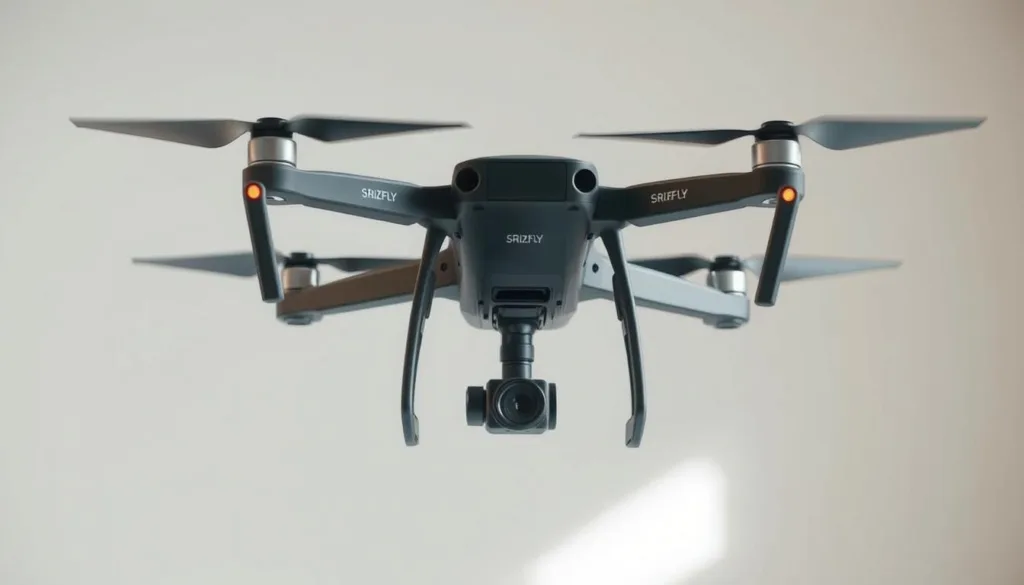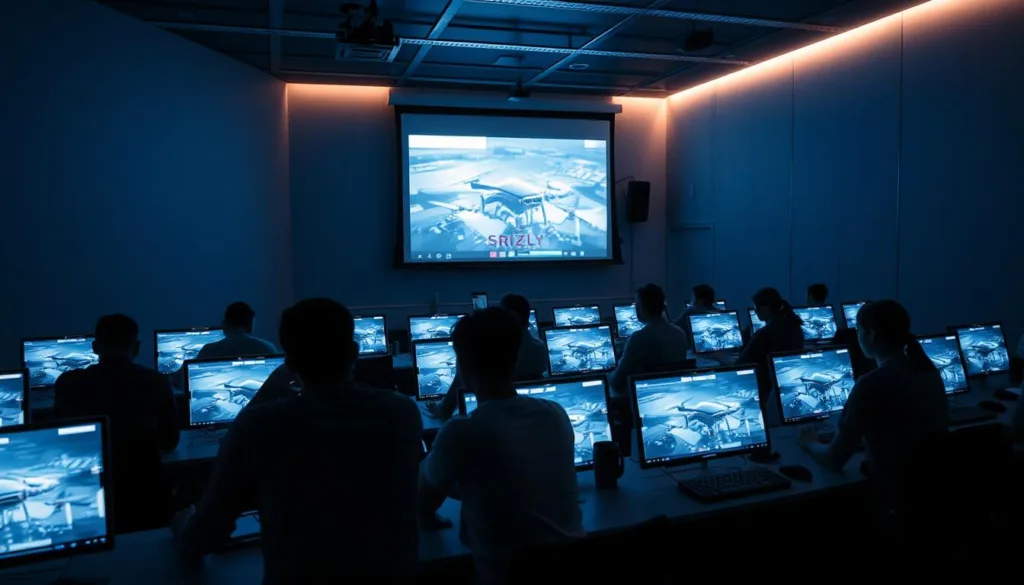Schools today need creative ways to prepare learners for careers where tech skills matter. Industries like engineering and environmental science increasingly rely on unmanned aerial systems. But traditional training often comes with high costs and safety risks.
Simulation technology solves these challenges by letting students practice without real aircraft. Platforms like SRIZFLY’s flight simulators offer risk-free environments to master controls and troubleshoot errors. This approach builds confidence through repetition—something physical drones can’t match economically.
Programs like NextWaveSTEM combine interactive lessons with tools like the TelloEDU app and Droneblocks. Teachers receive support through professional development, ensuring lessons align with STEM goals. Students design, code, and problem-solve while gaining skills for tomorrow’s job market.
Educational institutions now have access to affordable, scalable solutions. These programs turn theory into practice, sparking curiosity in tech fields. With safety and budget concerns addressed, schools can focus on what matters: inspiring future innovators.
Key Takeaways
- Simulators reduce costs and risks compared to physical drone training
- Hands-on practice builds technical confidence and problem-solving skills
- Curriculum kits integrate coding and design with real-world applications
- Teacher training ensures effective program implementation
- Prepares learners for high-demand careers in multiple industries
Introduction to SRIZFLY Drone Simulators
Cutting-edge simulation tools are revolutionizing how technical skills get taught safely. SRIZFLY’s platform turns classrooms into virtual airfields where learners master flight mechanics without crashing real equipment. Every detail matters—from how controllers feel in your hands to gusts of wind trying to knock your craft off course.
Overview of Advanced Simulation Technology
The system mirrors real-world physics so closely, you’ll forget you’re not outside. Built-in weather patterns like sudden storms or tricky crosswinds test decision-making skills. Interactive video lessons pair with practice sessions, letting users apply concepts like emergency landings immediately.
What sets these tools apart? Customizable challenges grow with skill levels. Instructors see live analytics showing who struggles with altitude control or battery management. The platform even simulates different aircraft models—each handles uniquely, preparing pilots for any machine they’ll encounter.
“You learn faster when mistakes don’t cost $2,000,” says a flight instructor using the tech. Real-time tips pop up during practice, turning errors into teachable moments. This approach builds muscle memory and confidence—critical for transitioning to physical flights.
Innovative Drone Courses for Students: Building Skills for the Future
Modern education programs now bridge classroom concepts with professional certifications. Age-specific lessons grow technical abilities through scaffolded challenges, preparing youth for emerging tech roles.

Empowering the Next Generation of UAV Specialists
Young learners start with tactile activities exploring lift and thrust principles. By middle school, they program flight paths using block coding. High schoolers tackle complex navigation algorithms while analyzing real-world UAV applications in agriculture and cinematography.
One instructor notes: “Watching 10-year-olds troubleshoot autonomous flights shows how quickly they adapt to tech.” This progression builds analytical thinking and operational confidence long before certification age.
Integrating FAA Part 107 Fundamentals
Advanced programs prepare candidates for the FAA Part 107 exam through interactive modules. Lessons cover airspace maps, weather patterns, and flight regulations. Simulation exercises reinforce concepts like emergency protocols and battery management.
Practice tests mirror the official exam format, helping learners identify knowledge gaps. Successful graduates understand both theory and practical requirements for commercial operations. This dual focus creates professionals ready to handle real-world aviation challenges from day one.
Comprehensive Curriculum & Flexible Learning Options
Educational programs now prioritize adaptability to meet diverse learner needs. Southern CT’s non-credit academy demonstrates this shift with its five-module structure. Participants mix standalone classes like photography basics and FAA prep to build personalized skill sets.
Tailored Pathways for Every Learner
The program’s modular design lets educators create focused learning journeys. Beginners start with foundation lessons on flight mechanics, while advanced users dive into 3D modeling. Each course maintains clear progression without locking users into rigid timelines.
| Module | Focus Area | Format |
|---|---|---|
| Landscape Modeling | 3D mapping techniques | Video + simulations |
| Photography I/II | Camera operation | Interactive projects |
| FAA Prep | Regulatory knowledge | Practice exams |
Self-paced materials accommodate different schedules. Visual learners benefit from 80+ video lessons demonstrating flight patterns and editing tricks. “The mix-and-match approach keeps our club members engaged,” notes a high school robotics instructor.
Educators receive ready-to-use lesson plans and troubleshooting guides. Online access lets users review concepts anytime, turning commutes or study halls into learning opportunities. This flexibility helps schools offer specialized training without overhauling existing programs.
Advanced Technology & Safety Features in Drone Training
Modern training programs are transforming how pilots master aerial technology while keeping budgets intact. Cutting-edge simulators now replicate real-world physics with startling accuracy, letting users learn through trial and error—minus the expensive crashes.

Crash-Proof Skill Building
Imagine practicing emergency landings in hurricane winds or navigating equipment failures. Simulation platforms let users attempt these high-risk scenarios repeatedly until reactions become second nature. “Trainees gain operational confidence faster when consequences disappear,” explains a certified flight instructor.
Budget-Friendly Mastery
Schools save thousands by skipping pricey equipment purchases. No replacement rotors. No liability insurance hikes after mishaps. Learners still get authentic flight experience through dynamic weather patterns and terrain challenges built into simulations.
Smart Scenario Design
Training modules adapt to skill levels:
- Beginner modes focus on steady hovering
- Intermediate challenges add camera controls
- Advanced tests simulate search/rescue missions
Built-in video lessons pause simulations to explain complex concepts like battery management. Performance dashboards help instructors spot who needs extra help with navigation or safety protocols before live flights.
Career Opportunities and Educational Impact
Emerging technologies are reshaping career landscapes faster than ever before. Hands-on training programs equip youth with tools to thrive in fields like urban planning and cinematography. These experiences bridge classroom concepts with workplace demands through practical skill-building.
Strengthening STEM Skills for Future Careers
Career preparation starts with core technical abilities. Programs teach flight mechanics alongside data analysis tools used in real-world settings. Learners grasp aerodynamics through interactive simulations while mastering software for 3D mapping projects.
| Career Sector | Key Skills Developed | Relevant Industries |
|---|---|---|
| Aerial Imaging | Lighting control, editing software | Film production, real estate |
| Geospatial Analysis | GPS navigation, data interpretation | Agriculture, disaster response |
| Aviation Tech | Safety protocols, battery management | Transportation, logistics |
Educators emphasize practical application. “Our learners don’t just operate equipment—they solve infrastructure challenges using geospatial data,” says a STEM coordinator. This approach builds troubleshooting expertise applicable across engineering and robotics roles.
Industry standards form the program backbone. Lessons cover airspace regulations and ethical operation guidelines, mirroring professional expectations. Graduates enter workplaces ready to handle equipment maintenance and mission planning tasks.
Creative fields benefit too. Photography modules teach composition techniques for marketing campaigns, while video projects develop storytelling skills for digital media careers. These competencies open doors in entertainment and environmental monitoring alike.
Conclusion
The future of aviation education has arrived—and it’s more accessible than ever. Through innovative simulation platforms, learners gain real-world flight experience without risking equipment or safety. Programs like Drone Pilot Ground School demonstrate this shift, with graduates achieving exceptional FAA Part 107 exam results through bite-sized video lessons and practice tests.
Schools now bypass traditional hurdles like costly hardware purchases. Instead, they provide hands-on training that builds coding skills and regulatory knowledge simultaneously. This approach works: 97% first-time pass rates and perfect scores prove structured learning beats trial-and-error methods.
Career paths span from aerial photography to emergency response operations. By integrating certification prep into curricula, institutions create industry-ready professionals. “Our graduates don’t just understand aviation rules—they apply them in dynamic scenarios,” notes Alan Perlman, founder of UAV Coach.
Ready to elevate your program? Let’s talk about how we can support your aviation education goals with scalable solutions that inspire tomorrow’s pilots and innovators.
FAQ
Why is FAA Part 107 certification important for students?
The FAA Part 107 exam is required to legally operate unmanned aircraft for commercial purposes. Certification opens doors to careers in industries like photography, mapping, and inspections while ensuring compliance with aviation regulations.
How does simulation technology enhance learning?
Advanced simulators replicate real-world flight scenarios, allowing practice in weather, emergencies, and complex maneuvers without risking equipment. This builds confidence and technical skills before handling physical aircraft.
Are these programs suitable for beginners?
Yes! Courses are designed for all skill levels. Customized modules start with basics like controls and safety, progressing to advanced topics such as aerial photography and FAA Part 107 exam prep.
What safety features are included in training?
Simulations use collision avoidance systems, emergency protocols, and virtual airspace rules. Students learn risk management, pre-flight checks, and how to handle equipment failures safely.
Can these courses help with STEM education?
Absolutely. Training integrates physics, engineering, and coding, fostering problem-solving and critical thinking. These skills are valuable for careers in tech, aviation, and environmental science.
Are there flexible scheduling options?
Programs offer self-paced online lessons, live workshops, and on-demand video tutorials. This adaptability accommodates school schedules or part-time learners.
What career paths can this training lead to?
Graduates pursue roles in cinematography, agriculture, surveying, and public safety. Certification also strengthens resumes for STEM-focused college programs or aviation careers.
Do I need prior aviation experience?
No experience is required. Courses start with foundational knowledge, making them ideal for newcomers. Instructors guide students through every step, from theory to practical flights.



